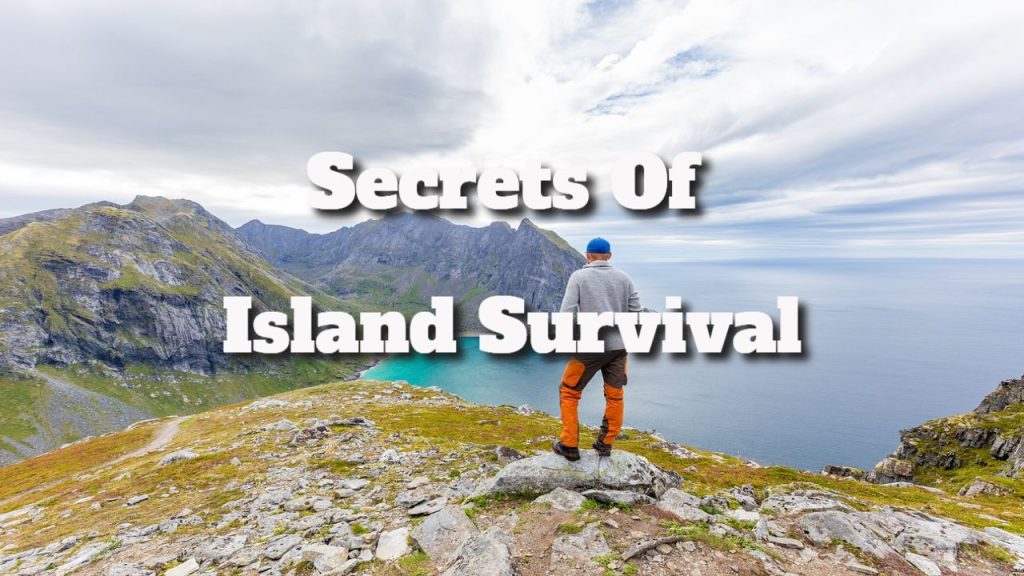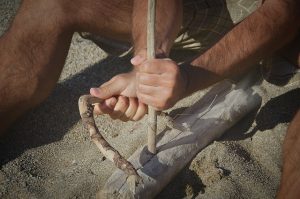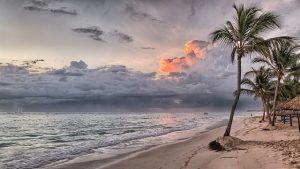Discovering the Secrets of Island Survival
Discovering the Secrets of Island Survival: Finding Out the Secrets of Island Survival: Recognising the island’s natural environment. Knowledge is the key to survival when it comes to surviving on a deserted island.
Understanding the island environment is crucial to your survival if you become stranded due to a shipwreck, plane crash, or other disaster.
First and foremost, you should become acquainted with the geography and climate of the island. The size, geology, and weather patterns of islands vary greatly, which affects your chances of survival.
Is the island a lush tropical paradise or a desolate wasteland? Is there a lot of rain or hot weather? Knowing these details will help you plan and make informed decisions.
Because water is essential for survival, locating freshwater sources should be a top priority. Look for streams, springs, or catchment places for rainwater.
However, drinking seawater directly may cause dehydration due to the high salt content.
Exploring the island’s vegetation can also provide information about possible water sources.
It is vital to become acquainted with the plant life on the island. Some plants provide delicious fruit, but others are poisonous.
Even if hunger compels you to eat everything, exercise caution and learn to recognise edible plants through study or survival manuals. Knowing which plants are safe to eat is critical for survival.

Becoming acquainted with hunting, fishing, and gathering practices would also be beneficial. You may have to rely on your ability to make traps, employ improvised equipment, or participate in other archaic hunting methods depending on the species on the island. Foraging for edible insects, shellfish, or marine plants can supplement and replenish your nutrition.
Building a shelter is another critical aspect of survival on a deserted island. Severe weather, from searing sun to torrential rain, can instantly impact your health. Make a sturdy shelter from available resources such as branches, leaves, rocks, or even wreckage to keep you safe from the weather.
Remember that your resources are limited while navigating the island’s harsh landscape. Long-term existence requires prioritisation and inventory management. Torches, spotlights, and signal reflectors can assist you in attracting attention and alert potential rescuers. It is also vital to ration available food, water, and resources until relief arrives.
Understanding the island environment includes more than just familiarising oneself with the physical scenery; it also entails being aware of potential risks. Various animals may live on islands, including venomous snakes, predators, and dangerous insects. Learn about the wildlife in your area to avoid unpleasant encounters and to defend yourself from potential dangers.
Knowing the terrain, climate, water supply, flora, and animals of the island will help you complete this difficult homework. The challenge, however, awaits as we study the strategies and skills required to survive a marooning situation.
Now that we’ve covered the fundamentals of understanding the island environment let’s look at some extra survival techniques and talents.
Fire provides warmth, illumination, shelter, and water purification on cold evenings. Learning how to build a fire from the materials available is vital.
To build a small tinder bundle, look for dry wood, leaves, or moss. Once the initial flame is lit, add fuel slowly to keep the fire going. Keep in mind that wildfires can spread quickly. Always be aware of your surroundings and practise fire safety.
Another essential skill to learn is first aid.
Because medical attention may be difficult to obtain in such a remote place, it is vital to treat minor injuries and illnesses independently.
Make a first-aid kit at home containing bandages, antiseptic wipes, and pain medicines. Learn the fundamentals of wound care and how to treat common diseases and recognise potential symptoms of infection.
Look for medicinal plants in your area that can help with your recovery.
While self-sufficiency is essential for survival on a secluded island, maintaining hope and a positive outlook is equally essential. Isolation and the constant effort to survive can have disastrous psychological consequences.
Sometimes, one is expected to feel unhappy or frustrated, but finding ways to stay psychologically intense is vital.
Maintain a journal, set daily goals, or seek shelter in nature as activities that provide a sense of purpose and normalcy. Connect with your surroundings and take in the island’s beauty to replenish your spirit.
One issue you may have is losing track of time as it passes. Without the usual daily life markers and rituals, losing track of time is easy. Making a primary calendar out of natural materials may assist you in keeping track of time and orienting yourself.
Mark each day that passes on a stone or shell to keep a modest sense of rhythm and progress.
Preparing for a possible rescue is one of the most important aspects of surviving on a deserted island. Setting up a way to inform passing boats or planes of your presence is vital. This can be performed by making a visible SOS sign out of stones, shells, or leaves and setting it on the beach or by using a mirror or reflective material to attract the attention of potential rescuers.
Making loud noises with pebbles or blowing a whistle may also draw attention to your location. Regularly scan the horizon for signs of civilisation and be ready to communicate if necessary.
Understanding and adjusting to the island’s ecosystem is vital if you get stuck. Understanding the island’s geography, climate, water sources, and vegetation. With the assistance of fauna, you can locate the materials you require and make informed judgements. Furthermore, learning skills like firemaking, first aid, a positive mindset, and rescue signals can greatly increase your chances of surviving this terrifying expedition.
Your expertise will be your most valuable advantage during a crisis. With careful planning, resourcefulness, and resilience, you can discover the secrets of island survival and tackle the insurmountable challenges that await you.
Create A Haven And Ensure Your Safety
Surviving on a desert island can be a difficult task fraught with problems. A stranded adventurer needs to build solid shelters and maintain personal safety.
Shelter construction requires ingenuity. As you survey your surroundings, gather materials that nature provides in abundance. Your shelter’s basis can be solid branches, massive leaves, and adaptive vines.
Look for natural cover, such as rocky overhangs or dense foliage, and use these pre-existing aspects to reduce construction time.
The lean-to shelter is dependable. While building a lean-to, find a sturdy branch or a tree with a low-hanging limb to use as a ridge pole. Anchor one end of the ridge pole to a solid surface, such as a large rock, and the other with vines or strong branches.
Place leafy branches against the slope of the ridge pole to create a sloping roof. This simple construction offers essential rain and wind protection while conserving energy and materials.
For added security, you can build a shelter out of rubble. Locate a sturdy tree with many branches close enough together to form a U-shape. Lay a long, thick branch horizontally across the bottom of the U-shape to form a foundation for your shelter. Next, tightly pack smaller branches and twigs around the base to produce a strong barrier against the elements.
Collect large amounts of grass or leaves to cover the roof and provide additional protection from rain and freezing winds. The debris shelter shields you from the elements while concealing your presence outside.
In addition to providing shelter, protecting yourself from potential threats is vital to your survival. The island may appear beautiful, but it is home to various dangerous species. To keep predators at bay, be aware of your surroundings and take the necessary precautions.
Surround your campground with thorny plants, impenetrable vines, or jagged boulders to keep intruders at a distance. This deters animals and adds an extra degree of security.
Also, keep your food away from your lodging because the scent may attract hungry animals. Keep the food out of reach of scavengers by hanging it from a strong branch or storing it in a tightly sealed container.
It is critical for survival to have a safe location to sleep at night. A raised sleeping platform deters ground-dwelling animals. Build a raised bed out of logs or branches for stability and comfort. This provides additional security and minimises the likelihood of seeing animals while sleeping.
We leave you with the knowledge of how to build shelters and give protection as the sun dips below the horizon, indicating the end of this first section of our chapter. Building a sturdy lean-to or debris shelter will keep you safe from the elements, while predator-deterrent measures and a good night’s sleep will allow you to face the island’s challenges confidently.
In the second part, we’ll look at other techniques for securing your home and boosting your survival skills on the island, which will be published later. Prepare to be startled as we delve deeper into the mysteries that await us, revealing a world of surprising and enigmatic realities. We will look into different methods and ways to improve your chances of survival as we continue our inquiry into building shelters and obtaining security on your desert island.
A critical feature is water collection and purification. In this challenging environment, having access to clean water is essential. Look for probable water sources while you explore your surroundings.
Look for water indications, such as lush vegetation or animal paths, that point to a specific spot. If you dig a little hole near these signs, you could find seeping water you can collect.
Remember to filter and sterilise any water you come into contact with because it may contain dangerous bacteria or parasites. To lower the risk of waterborne diseases, make a temporary purifying system out of natural materials such as sand, gravel, and charcoal.
Now that we’ve taken care of shelter and water let’s move on to food acquisition. While the island has abundant natural resources, competent hunting and gathering techniques are required for a well-rounded diet. Learn about the local flora and fauna and how to recognise edible plants and animals.
When harvesting plant foods, look for identifiable fruits, nuts, and edible plants. However, exercise caution while experimenting with new plant species; some can be hazardous or cause significant reactions. Learn to recognise various types of leaves and berries and use available resources wherever possible.
When seeking proteins, connect with the routes to build bare traps like snares or a catapult. To make these traps, use locally available materials such as vines or sharp wooden spikes. Although larger species may appear more tempting, smaller animals such as birds, lizards, or insects require less time and money to trap.
Let us now consider fire, the ultimate survival tool. Fire can cook, purify water, ward off predators, and keep warm. Collect a bunch of dry, dead leaves that will ignite to start a fire.
Rubbing dry sticks together or using flint and steel are two traditional methods for creating friction and starting a flame. To reduce unintended forest fires, follow proper fire safety precautions and thoroughly extinguish the fire before leaving the area.
Physical strength, mental fortitude, and adaptability are required for survival on this island. Accept the difficulties, remain vigilant, and educate yourself on island survival. If we work together, we may conquer the unknown threats in this perplexing region and learn the secrets ahead.
Getting Food and Water
Surviving on an island may appear complicated, but with the proper knowledge and skills, you can obtain food and ensure a clean water supply.
The first and most important aspect of island survival is food acquisition. When stranded on an island, you must rely on your wits and numerous natural resources.
On an island, the sea itself is an essential source of food. Fishing may give a steady supply of protein essential for maintaining muscle and stamina. Simple fishing tactics that may boost your chances of catching food include hand lines, improvised hooks made from bones or shells, and even creating fish traps.
If the water fails to yield results, you should look into the island’s interior. Food plants, fruits, and nuts can be found in land vegetation. Use caution when identifying the plants because some of them are dangerous.
Learn about the local flora or stick to universal foods like coconuts, bananas, and wild berries. Furthermore, for those willing to hunt, exploring the island’s diverse ecosystems may offer new food sources, such as edible insects or tiny mammals.
While food is necessary, clean and sufficient water is critical to existence. Without a doubt, the importance of being hydrated cannot be stressed. Fortunately, most islands offer several water acquisition options. The principal water sources are freshwater rivers, rainfall, and groundwater reservoirs. Let’s take a closer look at each of these alternatives.
If there are freshwater streams on the island, they can provide an immediate and reliable source of hydration. These streams come from natural springs or precipitation runoff and are often drinkable. If you have any doubts about the safety of the water, boil it or filter it. Remember that dirty water might trigger serious diseases, aggravating your situation.
Rain, a natural gift on an island, can be a lifeline. Collecting rainwater is a straightforward way to guarantee there is enough water. Making catchment systems out of leaves, fallen branches, or clothes can help collect and store rainwater more efficiently. It is vital to use appropriate containers for collecting and storing water to avoid contamination.
Finally, investigating the island’s underground resources could lead to the discovery of groundwater reservoirs. These aquifers, buried beneath the surface, can provide a constant fresh water supply. Look for areas with lush, abundant vegetation since this could indicate the presence of an underground water supply. Shallow wells or critical filtration systems may be required to extract and purify groundwater, depending on the island’s geology.
In the first half of the chapter, we covered various methods for gathering food and water on a desert island. As we adjust to our new surroundings, we must forage on land and sea and seek available water sources.
Our struggle for long-term survival on an island, however, continues. In the second half of this chapter, we will look at complex ways to ensure a constant food supply and alternative water purification procedures to equip you with the knowledge you need to unravel the mysteries of island existence.
In the second half of this chapter, we’ll look at complex methods for ensuring a steady food supply and alternative water purification procedures to arm you with the knowledge you need to uncover the mysteries of island survival. If you are determined and inventive, you can survive in this challenging environment.
When you’ve mastered the foundations of food collection, it’s time to widen your horizons and investigate more advanced methods. You can improve your fishing skills by making fish traps from natural items such as pebbles or driftwood.
These traps can be strategically placed in areas with a high concentration of fish, increasing the chances of a successful catch. If you learn to make and use a fish spear, you can catch larger fish or even tiny marine creatures, providing a more diverse food source.
As you explore the island’s core, remember that edible plants can be discovered on the ground and in the higher tiers of the trees. Climbing or using equipment to reach the upper branches will allow you to reach fruits and nuts that are difficult to reach from the ground. Be cautious, however, and ensure these weird foods are safe before consuming them.
If you have the necessary skills and grit, small-game hunting can be a rewarding experience. Learn about the island’s species and habits by observing and learning about them. Small animals can be captured using homemade traps or snares, resulting in a varied and nutritious meal. Remember to respect nature by harvesting only what you require to survive.
When it comes to water, examining various harvesting methods and purifying this precious resource is necessary. If no freshwater rivers are accessible, looking for swampy areas or natural depressions where rainfall can accumulate may be necessary. Simple sand and charcoal filtration devices can remove contaminants and improve the flavour of collected water. Boiling water is still the most reliable method of water filtration since it kills any harmful bacteria and parasites that may be present.
You should look into alternative methods if you reside where freshwater is scarce. One such method is to construct a solar system. Condensation produced by the sun’s heat can be collected by excavating a hole in the ground, placing a container on the bottom, covering the hole with a plastic sheet, and fixing the sides. This condensed vapour drips into the container, providing a somewhat pure source of drinking water.
Furthermore, coconut milk can be used as a natural electrolyte replacement and hydration source. To replenish the nutrients lost via sweat, crack open a coconut and drink the delicious juice.
You must be adaptable and prepared to learn new survival abilities on a desert island. By honing your fishing skills, exploring the island’s vegetation for edible plants and fruits, and mastering hunting and trapping, you can ensure a consistent supply of nutrition.
Seeking and purifying water from various sources, such as rainwater and underground reservoirs, will also help you stay hydrated and healthy. Remember that long-term survival on an island requires perseverance and ongoing research. Accept the challenges and opportunities that will come your way as you embark on this life-changing journey.
Getting Around And Signalling For Help
In a case where every second counts, knowing how to navigate the island and signal potential rescuers can be the difference between lost and saved.
Navigating a remote island requires good observation skills and a strong understanding of the environment. Look for landmarks like enormous trees, odd rock formations, or other geographical features that can adequately point you. Make mental maps or even concrete symbols to mark these locations.
The sun may be your best buddy when it comes to navigating. Observe how the sun rises and sets during the day. In the morning, the sun rises in the east, making it a reliable compass. By noting the direction of its rising, you can determine the broad directions of north, south, east, and west. In the evening, the sun sets in the west, offering another reference point. Understanding the cycles of the sun may provide helpful information about your surroundings.
The stars, in addition to the sun, function as a celestial compass. Look up into the sky on a clear night and try to distinguish constellations or individual stars. The North Star, also known as Polaris, can serve as a steady reference point because it is aligned with the Earth’s axis of rotation. Finding the North Star lets you determine approximate directions, making it a valuable navigation aid.
As you investigate your surroundings, you may see natural cues correctly pointing to you. Look for changes in the vegetation or animal behaviour. For example, some trees grow asymmetrically, with branches bending in a specific direction due to prevailing winds. Birds frequently migrate in specific directions and fly in precise directions. Pay attention to these natural cues to learn about the island’s geography.
It is vital to provide indicators for potential rescuers to maximise your chances of being found. The most effective signals stand out from a distance and convey a clear message. Lighting a fire is a common practice. Smoke is visible from a distance, especially with water in the background. Collect dry branches, leaves, or other flammable items to create a smoke signal to attract passing ships or planes’ attention.
Reflective surfaces, in addition to smoke, can provide visual information. To aim sunlight towards potential rescuers, mirrors, aluminium foil, or improvised reflective materials such as CDs can be used. Hold the reflecting surface in your hand and move it so that the sunlight is reflected in the proper direction, offering a beacon of hope among the immensity of the island.
Acoustic cues should also be taken into account. Sounds like banging stones together or making rhythmic patterns with logs can warn nearby ships or planes of your location. Remember that sound travels well across the water, so use its amplification effect.
Knowing the fundamentals of navigation and signalling increases your chances of being found and saved on a desert island.
Survival necessitates exploring a desert island and sending out good rescue signals. In the first half of this chapter, we looked at various strategies to help you locate your way and attract the attention of potential rescuers. Let’s look at some more sophisticated tactics and ideas that can assist you in being found and eventually rescued.
Using the resources available on the island is vital to improve your navigation efforts. Keep an eye on the riverbed, as rivers and streams often flow into the sea. By following a water source, you can not only quench your thirst but also find an ideal path to a possible rescue. Furthermore, visitors to the shoreline may uncover secret coves, inlets, or other landmarks that are not visible from the island’s centre.
Watch for artificial structures or remnants of previous communities as you explore the island. These could be old campsites, shelters, or simply trash. Previously stranded people may have left hints or valuable gadgets to help you survive. Examine these areas attentively because they may contain essential items or indications for a future rescue.
It may be necessary to travel deeper inland and check your immediate surroundings. Keep a reference point or use tactics to build trail signs to avoid becoming lost. You can mark your path with ribbons, clothing, or even tree carvings while alerting potential rescuers who may find you.
When it comes to signalling for aid, taking advantage of any opportunity is vital. While smoke signals and reflective surfaces are helpful during the day, nighttime rescue scenarios require additional communication methods. After the sun goes down, fire reverts to being a helpful tool. A burning fire can provide warmth and protection throughout the night and function as a beacon for rescuers doing nighttime operations.
You can also increase your chances of attracting notice by producing sound signals at night. Use sound-producing instruments such as whistles, horns, or improvised percussion instruments. Neighbouring rescuers can hear these sounds since they can be broadcast over the island.
When it comes to increasing your visibility, clothing is essential. Make flags or banners out of bright materials or old clothing. Place these in a conspicuous location, such as on a hill or near the coast. Bold, contrasting patterns and colours will attract attention and aid potential rescuers in locating you from a distance.
Keep optimism and perseverance in mind throughout your stay on the island. Being alone can have gloomy psychological consequences, and it is expected to experience bouts of despair or mistrust. However, if you stay focused, use your resources wisely, and employ good signalling skills, your chances of rescue will skyrocket.
To recap this chapter, continuing to practise and refine these navigation and signalling tactics is vital. Patience and tenacity may be required on the road to safety. Nonetheless, by employing the aforementioned strategies and hunting for potential gaps, you will increase your chances of being discovered and, ultimately, saved.
Maintaining One’s Mental and Emotional Health
Learn the importance of mental health while stranded on an island and how to preserve inner strength and tenacity throughout the survival fight.
Natural treasures abound on an island in the middle of the vast ocean, but they also face the challenges of isolation and unpredictability. Maintaining mental and emotional well-being is essential for people stranded in such a remote paradise. Physical survival skills are crucial, but so is the ability to retain a resilient mindset in the face of island life’s obstacles.
When left on an island, the loss of familiar surroundings, loved ones, and a sense of security can quickly take its toll on mental health.
When people affected are confronted with the harsh reality of their circumstances, they must acknowledge and handle the emotional rollercoaster. Understanding the importance of mental health in this difficult situation may boost an individual’s chances of surviving dramatically.
Priority should be given to the development of resilience. You can learn to recover from adversity by fostering resilience, which is the ability to keep going even when things get complicated.
Individuals who cultivate resilience can better weather the mental storms that precede abandonment. Practising Thanksgiving is a fantastic way to boost resilience. Focusing on what you still have rather than what you’ve lost can help you change your perspective and find hope.
Creating structure and routine is also essential for maintaining mental balance. Daily rituals like exercise, meal preparation, and shelter maintenance provide a sense of purpose and normalcy. When brought into island life, the routine provides a foundation for sanity and eliminates emotions of aimlessness or despair.
Connecting with nature can also help you keep your mental and emotional health in check. When the boundless beauty of an island surrounds you, you can take advantage of nature’s calming and therapeutic properties.
Listening to the soothing sound of the sea, watching the elegant motions of plants and animals, or feeling the warm touch of sunlight can bring moments of peace, comfort and relief from the problems ahead.
Maintaining social contact is also beneficial for persons who are trapped. The value of companionship in times of loneliness should not be underestimated. It is vital to seek comfort, support, and camaraderie from other survivors, as they are experiencing similar challenges and concerns. They can offer emotional support and an empathetic ear and foster a sense of belonging, all essential for psychological well-being.
It’s critical to remember that maintaining mental and emotional well-being is a continuous process as days turn into weeks and weeks turn into months. Living on an island presents unique problems that can be solved by focusing on resilience, building structure, connecting with nature, and socialising.
On the other hand, the force of the human spirit should be acknowledged, and true inner resilience is regularly tested when confronted with the unexpected. The farther our survivors go into seclusion, the more mental and emotional challenges they face.
When you’ve been isolated for an extended period, it’s normal for fear and doubt to creep in. The ambiguity of their situation can exacerbate existing concerns or create new ones. To deal with these frightening feelings. Survivors should use their imagination to improve their psychological and emotional well-being.
Individuals can process their experiences and make sense of their circumstances by reflecting on and learning about their thoughts and feelings.
Keeping a journal, meditating, or conversing intelligently with other survivors can all give a safe environment for self-expression and thought. Understanding their feelings and ideas can help our survivors build a sense of self-awareness, which is essential for maintaining emotional stability.
They seek meaning and purpose in their daily acts, in addition to self-reflection. It’s all too easy to succumb to the sadness that comes with abandonment, but our survivors must push themselves to find meaning in their survival efforts.
Whether learning new skills, engaging in creative interests, or finding solace in a daily ritual, filling each day with purpose can offer a sense of completion and optimism to their existence.
It is also vital to maintain a positive attitude. While it may be easier said than done in such difficult circumstances, intentionally concentrating on the positive can be life-changing.
Instead of dwelling on their hardships, our survivors must be grateful and identify even the most minor accomplishments and sources of joy. Our stranded explorers can find resilience and optimism in adversity by concentrating on the positive.
Another excellent way to maintain mental and emotional well-being is to cultivate a connection to higher forces or personal beliefs. Spirituality or faith can provide comfort and guidance that should not be underestimated.
Amid the island’s seclusion, our survivors can connect with their inner selves, find serenity in prayer or meditation, and find strength in their deepest beliefs. Individuals might find solace, guidance, and a renewed sense of purpose by reflecting on their spiritual convictions when travelling.
As the days turn into months, the survivors will continue to fight with their inner demons and navigate unknown emotional terrain.
The island’s mysteries tempt and demand that the survivors show fortitude, flexibility, and self-awareness. On this challenging journey, equipped with new knowledge and tactics, their resilience will be tested, and their inner strength will be the driving force that propels them forward.
The post Discovering the Secrets of Island Survival appeared first on Survival Avenue.
The post Discovering the Secrets of Island Survival appeared first on https://gqcentral.co.uk





Comments are closed